#A lot of characters are like that for me - their common designs from 2010-2015 shaped how I imagine them now so newer cats tend to be more
Explore tagged Tumblr posts
Text

#Day 237#Warrior Cats#Nightcloud#No strong feelings about her tbh since I haven't read many of the newer books and I just don't remember her much from PO3/OOTS#She didn't deserve anything that happened to her though#I've always imagined her as short-furred because of the Nightcloud's Tale storyboard by hikari2314 which I watched before I read any of her#appearances in the books#Otherwise I'd probably imagine her as longer furred now#A lot of characters are like that for me - their common designs from 2010-2015 shaped how I imagine them now so newer cats tend to be more#varied in designs#I like the idea of her having purple-ish pupils idk#I have a dark background because you can't see her if I just left it transparent or bright since color theory#2023 Daily Drawing Challenge
4 notes
·
View notes
Text
Blu Blogs: First Thoughts on OK K.O.!: Let's Be Heroes
So after a long day of highs and lows, I arrive home at around 5:40 pm with little expectation for anything big. I'd already heard about the teaser picture of Metal's leg and how Smash is totally, maybe (stay-tuned-for-more-news-because-this-is-how-Nintendo-rolls), coming to Switch . At best I was expecting the highlight for the new content to be some cute new thing related to NEO-KOSMOS (even though we just got a new update the day prior). But no. We got something big, something unexpected. We got...
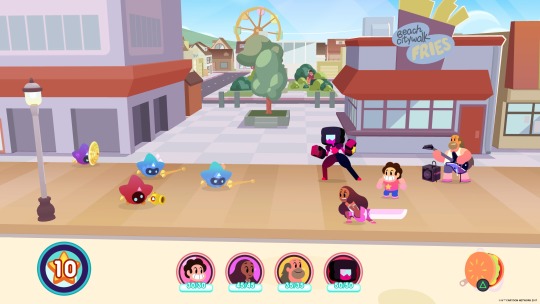
STEVEN UNIVERSE: SAVE THE LIGHT (A SEQUEL TO THE 2015 APP ATTACK THE LIGHT) WHICH IS A FULL FLEDGED CONSOLE RPG WITH PAPER MARIO GAMEPLAY, 4 PLAYABLE PARTY MEMEBERS BEYOND THE 4 MAIN CRYSTAL GEMS AND A NEW STORY WRITTEN BY REBECCA SUGAR YEEEEEEEEEEEEEEEEEEEEEES
But that isn't what we're here for today. Today we're here to talk about the long-awaited show 3+ years in the making: Lakewood Plaza Turb--

Oh.
So I log onto tumblr and the first thing I see is this:

So my eye is immediately drawn to the girl because girls are cute she's in the foreground, and I just don't recognize her. I look at the other characters and think "wait is that rad and k.o. what the HELL is going on". So logically, that means the girl is enid, ergo something is going on relating to Lakewood Plaza Turbo. I read the comment below that said "woooo OK KO! theshow i’ve been boarding on for over a year is finally announced!!!!"

I immediately have SO. MANY. QUESTIONS. Is the series getting another app? More shorts? A game? What's going on?! And as I scroll down the truth comes alll the more clear:
Lakewood Plaza Turbo is finally becoming a show.

REDEMPTIOOON SOOOOOOOONG
But not without some changes (ala Steven U). The artstyle, name of the show, and theme were all changed and just like Steven U my kneejerk reaction was "what the fuuuuck IIIIIIIIIIIIIIS this shit?". And also like Steven U it quickly grew on me and I accepted that this was the righteous path. Well, the artstyle and theme anyway, I'm still a bit iffy on the name. But enough context, let's talk about the show!
ok i lied, more context. so part of what contributed to my kneejerk reaction was the fact that Lakewood Plaza Turbo was in development purgatory for 3 years and in that time we got the app/shorts, but also in that time shows that had been in circulation for less time like We Bare Bears and Magiswords had gotten onto CN without seemingly as much struggle. I'd just given up hope for the series becoming a show and on top of that I'd even begun to lose my liking for the pilot, but then again Early Installment Weirdness is my Achilles heel of Tropes so make of what what you will. So when I saw the show come back in such a different form I was instantly turned off. Just from how it looked I was getting Teen Titans Go! & PPG16 vibes: a loss of the show's soul.
The artstyle looked so rudimentary and basic and the theme/intro wasn't doing it any favors, with its lyrics being very non-infortmative to the premise of the show: all fluff no substances. I had come to really like Lakewood Plaza Turbo's theme because its lyrics just felt as though they encompassed the tone and subject matter of the show: stupid(in a good way)ly-awesome with a video game/anime flare). But this was just....a non-event. And once again, the simplistic artstyle is so lame! Until I began to think of it another way...
Lakewood Plaza Turbo/OK K.O.! are clearly rooted deeply in gaming/anime culture and in some ways the new theme, title, and artstyle reflect this. Starting with the new theme, check out the opening shot of it panning from space all the way down to the plaza and the shot of K.O. staring down Lord Box Man with the opposing sides behind them.

Not only is this shot really badass, but it just REEKS of anime influence! And that extends to the theme! The simplistic subject matter and referenec to being friends/heroes feels very reminiscent of 90's anime with Engrish lyrics that have a very simple, positive vibe. It fits! The subtitle "Let's Be Heroes" also reflects it but I'm not as fond of it. You know it's going to be akin to "Adventure Time with Finn and Jake", "The Amazing World of Gumball, "The Marvelous Misadventures of Flapjack" and "The Adventures of Jimmy Neutron: Boy Genius": extra parts of the title that'll all be abandoned in advertising and common discussion in a year. Regardless, the title/opening grew on me. And the artstyle? Awesome! While initially reluctant I came to realize that Lakewood's artstyle wasn't all that impressive. I never really liked K.O. and Enid's noses so the cute little square Elmo/Stan Pines gumdrop is cute.

Precious.
And in general, Lakewood sort've had a generic 2010s base artstyle. It definitely had defining features such as the eyes, aforementioned noses, and character designs but the colors used along with the thin lines didn't do much to set it apart. The new proportions, radically unique way of drawing things, and scraggly crayon-like lines should help. I initially thought the style was too squishy and inconsistent but not in the good, Ren and Stimpy/Steven Universe way. But after I got addicted to the visuals in the opening, I began to really enjoy the style and see the merits of it. Especially in this shot.
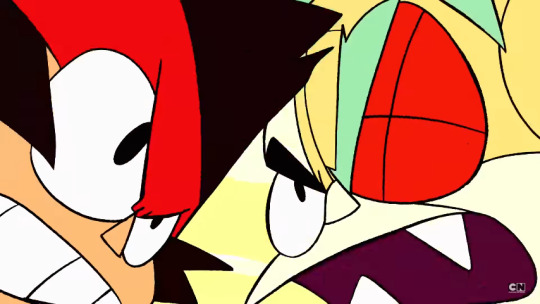
It looks SO cool.
I have no idea what this artstyle resembles but the closest I can attribute it too is Sonic CD/Mega Drive and Mega Man which I LOVE.

Also forgot one thing! Both Mega Drive and OK K.O.! have scraggy outlines
It does wonders for K.O., Carol, Lord Box Man (especially Lord Box Man, the way his mouth is drawn all muppet like gives him a real sense of dimension and it's great),

Perfection.
and the other tertiary/background characters but Enid, Rad, and Mr. Gar...

Umm....
Yeaaaaah. Now granted, that opening shot of them isn't doing many favors since admittedly they look REALLY bad (mostly Enid), but even without it they still look a bit. The simple geometrics really makes Gar and Rad's muscles look not very good due to how, well, simple they are. Enid on the other hand suffers an almost opposite issue—her legs are sometimes drawn with definition/shape (like with the black and white photo storyboarder's picture from the beginning of the Blog) which makes sense considering she's probably based on Chun-Li. Other times, like the picture just above this paragraph, and this one:
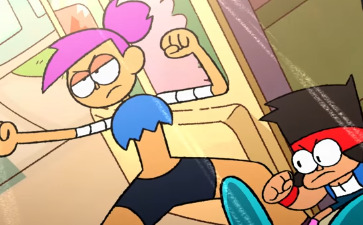
Her legs are basically parallel lines that bend. Even worse is that shot above seems to be from an actual episode, meaning Enid will likely look like that a lot. In general, I think I don't think I'm happy with the new design choices for Enid. Not only is there the leg thing, but her ponytail and bandaged torso from Lakewood were a lot more appealing.

Even so it's not impossible to make any of these design choices look great. Just check out the official poster and you'll see all of them, especially the 3 we've been talking about for the past while look great.
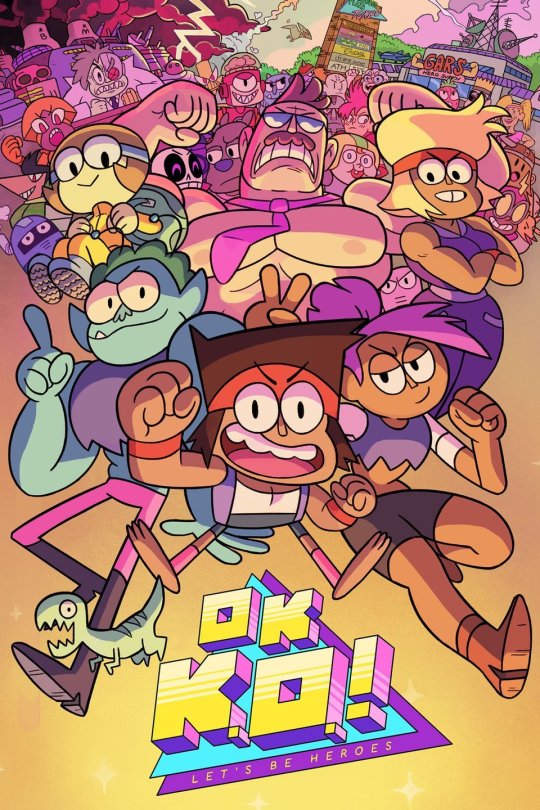
One last thing to note on Rad/Gar/Enid's proportions: The strange Garnet-esque chest proportions on Enid and Rad's shirts despite their lower torsos indicating that there's nothing under said shirts.
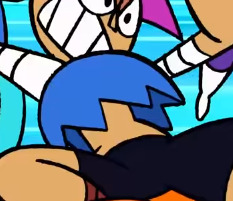
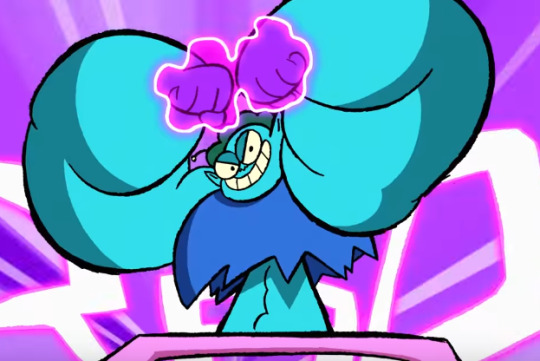
Enid is a bit more understandable, as nothing about her lower torso indicates that something should be up there but this man Rad is /shredded/. You should definitely be able to see his biceps leading into the shirt, as made evident by Mr. Gar. These don't necessarily detract from the excitement of the show, but they're worth note and could become problematic if made out to be very obnoxious out of proportion in show.
Two more design changes to note before we wrap up: K.O. has a darker skin tone (which I like) and now has buttface.
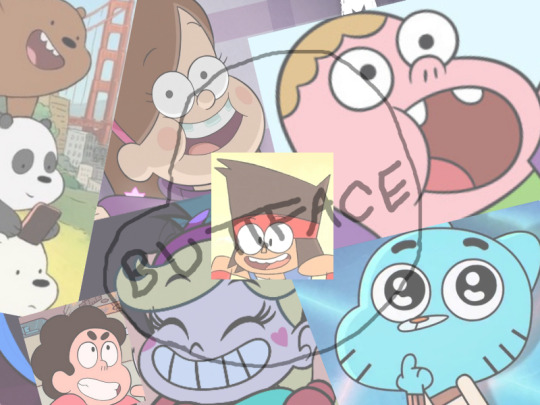
Buttface, along with flat simplistic colors and thin lines will go down as the defining aesthetic traits of the 2010s.
And also Rad's antenna have gone from being on the front of his forehead to in the middle of the top of his head, which looks a lot less awkward tbh. Overall good choice.
Despite the many issues it has, the artstyle still looks pretty different from everything else we have atm, and the simple way the characters are drawn should be beneficial as with said simple characters action scenes will be a lot easier to make and thus we'll be able to get higher quality, well-animated fight scenes. Despite the bad initial reaction, I have high hopes for OK K.O. Long as they keep the tone and spirit of Lakewood Plaza Turbo alive we could be looking at the next big show. Oh, and great on Ian for percerviering and becoming the second African American to create a CN original. Can't wait to see the young K.O. rise up to greatness just like his creator.
p.s. for being the defensive teammate, steven's hp sure is garbage in that screenshot of attack the light
2 notes
·
View notes
Text
Bobby Steggert LMSW
Bobby Steggert, actor headshot
Ragtime, 2009 in his Tony-nominated performance as Mother’s Younger Brother
Ivan Hernandez and Bobby Steggert in Yank, 2010.
Big Love, 2015
Bobby Steggert, Frederick Weller, Grayson Taylor and Tyne Daly in Mothers and Sons, 2014
Two years ago, Bobby Steggert, a Tony-nominated actor with extensive credits on and Off Broadway (Ragtime, Big Fish, Yank! etc) , surprised the theater community by announcing that he had switched careers. In an article on Medium, he explained that he was in the middle of getting a degree in social work from Columbia University. “My master’s degree will be a piece of paper, but my life as an artist will make me a great social worker, this I know.” Since July of 2019, Bobby Steggert LMSW has been serving as a psychotherapist in private practice and a staff therapist at the Institute for Human Identity Therapy Center,. Three-fourths of his clients, he tells me, are “actors, singers, dancers, directors, writers, or designers,” and (his staff biography says) he comes to the therapy relationship with “warmth, humor, and a solution-focused approach.” He seemed the right person to ask about the specific mental health needs of theater artists during this stressful period, and he readily agreed to speak with me.
Have you had any new thoughts about your switching careers since you wrote that piece in Medium in 2018?
Time and retrospection have been even more clarifying. I think that what I struggled with most of all near the end of my performance life was a lack of meaningful purpose when not employed. This is obviously part and parcel of any freelance career, but a lot of that sense of purposelessness was within me, and in my inability or unwillingness to find sustainable and grounding purpose in other parts of my life. As a result, I focus quite a bit on finding purpose with clients, and how they can foster these essential elements of a satisfying life, even within the extreme limitations of a time like today.
Based on your own experience as a therapist, and that of your therapeutic colleagues, has there been a general uptick of mental health issues over the past few months?
Most definitely. I think that we are in a time of great anxiety as a culture and so of course that trickles down to individual experiences. There are a lot of people who are experiencing heightened anxiety and depression, and, as a result of that, dealing with an increase in substance abuse and also relationship issues and, of course, issues with unemployment and loss of income.
My colleagues and I have gotten quite a few inquiries from people who want to enter therapy. I am at capacity so I try to find other therapists for people who call me in order to get them treatment as soon as possible.
People are struggling pervasively because we have been challenged with unbelievable limitations. When you don’t have community and you don’t have a sense of purpose and you don’t have a source of income, those are definite recipes for mental health struggles.
I understand that every person is individual, but are there issues specific to (common in) theater artists during this time of pandemic and unemployment, or ways in which theater artists feel these stresses in a different way?
The most devastating thing about this crisis for theater makers is that there is really nowhere to turn for alternative employment in live performance. Theater artists are singularly gifted in creating work that is shared and felt in one communal, physical space, and in this moment, it’s practically an impossibility. We are all making major sacrifices right now, but theater artists have their hands tied in a way that is unique, and any adjustment to other work is felt as a true loss to one’s core sense of contribution.
What advice or words of comfort have you been giving to artists — or could you give to artists now?
The irony is that so many artists buy the line that they have “no real world skills” and yet they are the most creative, adaptive, and flexible people around. They are made for shifting and unexpected circumstances. They understand the vicissitudes of a highly inconsistent industry, which uniquely prepares them for a highly inconsistent time. I try to remind my clients that their fantastic relationship and communication skills alone make them highly qualified for any temporary adjustments to employment or living situations that are required of them right now. I also like to remind my clients that they are excellent at making meaning – that’s what artists do – and one major thing we have control over now is to make conscious, growth-oriented meaning out of our experiences, even when they’re terrible. And while many can’t make meaning through work right now, they can make it through their relationships, parts of their identities outside of the profession, their bodies through health and self-care, and their creative voices, whether broadcast to the world or quietly to themselves.
What about theatergoers rather than theater makers? Are you aware of ways in which the lack of live in-person theater has had a tangible, diagnosable effect?
I am not sure if I could call it diagnosable but I do think that humans benefit greatly from gathering in groups and physical spaces and in experiencing collective energy together. I think that is why theater is so special. That’s a huge reason why people, for example, attend church. Without that live shared energy, I think that is why people are suffering from loneliness even when staying connected to fiends and family through the Internet.
So what can people do about this?
I think it depends on people’s risk level and how far they are willing to go to be in contact with other humans, but I have suggested to my clients to find as many opportunities as possible to meet friends in the park or to be around other people in outdoor settings as a way to feel more physically connected to other humans.
It’s interesting that you talked earlier about finding purpose, because that of course is the main characteristic of your Tony-nominated role as Mother’s Younger Brother in “Ragtime.” Is that just a coincidence?
In retrospect, I think that as an actor the roles you play can teach you about yourself, and I do attribute that experience to be the seed of an investigation for myself as to how I could find more sustainable purpose than I was able to find as an actor who too often has to wait around for invitations to participate n what they do. Another role really taught me something — Will in “Mothers and Sons.” He was a young man who was so integrated into himself as a gay person. That character taught me that I needed to do more work to embrace the fullness of my own sexual identity.
So you’re saying that your roles helped shaped you as a person?
Very much so. When you inhabit them you take on their energy and you take on their psychology and if you are open to it , that character can teach you new things about yourself.
I admired your performances, and was struck by how much vulnerability you allowed your characters. Feel free to disagree with my premise, but, if you agree, was that vulnerability deliberate, a reflection of your own nature, or just a result of the roles for which you were cast? And is that quality a help or a hindrance or irrelevant to your new career?
I do agree with the premise. The purpose I did find as an actor was to expose the complexities of the human condition in a way that was raw and that was vulnerable. I think that is because I am naturally a more emotional and more vulnerable person. I think that quality inspires others to be more vulnerable, and so I find it very helpful as a therapist. I’m asking others to become more vulnerable and through that vulnerability to understand themselves and to experience life more deeply.
But do people seeking therapy want vulnerability, or rather somebody who seems confident and authoritative?
I think that the most important quality in a therapist is that the person feel safe with them. That sense of safety can help them to open up and to be braver in their own introspection. [My vulnerability] changes shape because as a therapist there are certainly boundaries, but at the same time I try to exist in a therapeutic relationship with total openness and with a certain kind of vulnerability that I hope can inspire others to be the same.
Where can people go for help?
I have two layers of an answers to that question. Specifically for theater people who are looking for mental health help, I think that the Institute for Human Identity is a great option because they have a lot of availability for therapists who are in the arts or who understand what it is to be in the arts. Another resource is the Actors Fund, which has a wonderful list of therapists who are also in some way connected to the arts. Those are the two places I would send theater people if they are looking to talk to someone.
On another layer, I think the best way to deal with stress especially under these circumstances is to find a physical practice, because being connected a one’s body is sometimes the best option. So I am finding that people are turning to yoga or exercise or mindful meditation.
But what if the theater person doesn’t have any money? As you said, most are unemployed now.
That is really rough. The Actors Fund also provides grants to people who are unemployed. There are also much more affordable options, such as a therapeutic apps called TalkSpace.
Is there anything about theater that you’ve used to help your clients – or yourself – cope with the stresses of the current situation?
I find it oddly comforting to think about Shakespeare’s time, in which London theaters closed several times due to the plague. He mentions the plague in several of his plays, including The Tempest and King Lear. And during the two year period between 1592-1594 when he couldn’t write plays, he turned to poetry. He adapted just like we all must.
If possible for us to telescope out of this very moment, and while acknowledging all of the suffering and hardship we are enduring, we can be reminded that human history is full of enormous disruptions to life as usual, and yet we keep moving forward, because we have to. Live theater will never leave us – and we will inevitably return to the day when we gather again to take in stories in ways that no other storytelling can replicate.
Centers for Disease Control: Coping with Stress
Bobby Steggart, Actor Turned Therapist Q & A: Theater Artists Are Suffering Two years ago, Bobby Steggert, a Tony-nominated actor with extensive credits on and Off Broadway (Ragtime, Big Fish, Yank!
0 notes